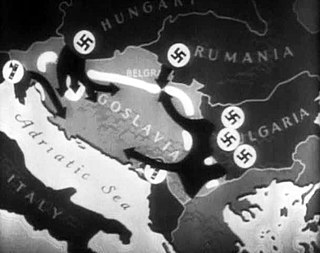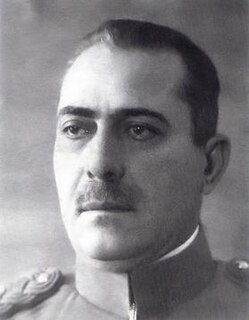| 9th Infantry Brigade | |
|---|---|
| Active | 1939 - 1942 |
| Country | |
| Branch | |
| Type | Infantry |
The 9th Infantry Brigade was a formation of the Royal Hungarian Army that participated in the Axis invasion of Yugoslavia during World War II. [1]
| 9th Infantry Brigade | |
|---|---|
| Active | 1939 - 1942 |
| Country | |
| Branch | |
| Type | Infantry |
The 9th Infantry Brigade was a formation of the Royal Hungarian Army that participated in the Axis invasion of Yugoslavia during World War II. [1]
The 1st Army was a Royal Yugoslav Army formation commanded by Armijski đeneral Milan Rađenković during the German-led Axis invasion of the Kingdom of Yugoslavia in April 1941 during World War II. It consisted of one infantry division, one horsed cavalry division, and two brigade-strength infantry detachments. It formed part of the 2nd Army Group, and was responsible for the defence of the section of the Yugoslav-Hungarian border between the Danube and the Tisza rivers.

The Yugoslav order of battle before the invasion of Yugoslavia includes a listing of all operational formations of the Royal Yugoslav Army, Royal Yugoslav Army Air Force and Royal Yugoslav Navy immediately prior to the World War II invasion of that country in April 1941.

The Axis order of battle for the invasion of Yugoslavia was made up of the various operational formations of the German Wehrmacht and Waffen-SS, Italian Armed Forces and Hungarian Armed Forces that participated in the invasion of Yugoslavia during World War II, commencing on 6 April 1941. It involved the German 2nd Army, with elements of the 12th Army and a panzer group combined with overwhelming Luftwaffe support. The eighteen German divisions included five panzer divisions, two motorised infantry divisions and two mountain divisions. The German force also included two well-equipped independent motorised regiments and was supported by over 800 aircraft. The Italian 2nd Army and 9th Army committed a total of 22 divisions, and the Royal Italian Air Force had over 650 aircraft available to support the invasion. The Hungarian 3rd Army also participated, with support from the Royal Hungarian Air Force.
The 2nd Army Group was a Royal Yugoslav Army formation commanded by Armijski đeneral Milutin Nedić during the German-led Axis invasion of the Kingdom of Yugoslavia in April 1941 during World War II. It consisted of the 1st and 2nd Armies, comprising four infantry divisions, one horsed cavalry division, two brigade-strength infantry detachments, and one horsed cavalry regiment. It was responsible for the defence of the border with Hungary from Slatina to the Tisza river.

The 2nd Army was a Royal Yugoslav Army formation commanded by Armijski đeneral Dragoslav Miljković that opposed the German-led Axis invasion of the Kingdom of Yugoslavia in April 1941 during World War II. It consisted of three infantry divisions and one horsed cavalry regiment along with supporting units. It formed part of the 2nd Army Group, and was responsible for the defence of the Yugoslav–Hungarian border along the Drava river from Slatina to the Danube.
The 3rd Army was a Royal Yugoslav Army formation commanded by Armijski đeneral Ilija Brašić during the German-led Axis invasion of the Kingdom of Yugoslavia in April 1941 during World War II. It consisted of two reinforced infantry divisions, two infantry divisions, and a brigade-strength horsed cavalry detachment. It formed part of the 3rd Army Group, and was responsible for the Yugoslav-Albania border between Lake Ohrid and Lake Skadar.

Milorad Petrović was an Armijski đeneral in the Royal Yugoslav Army who commanded the 1st Army Group during the April 1941 German-led Axis invasion of Yugoslavia of World War II. Petrović was commissioned into the Royal Serbian Army in 1901 and served in multiple staff positions during the Balkan Wars. During World War I, he served in various staff roles at the army and divisional level during the Serbian Campaign and later on the Macedonian front. Following the war, he took part in military operations along the disputed northern border of the nascent Kingdom of Serbs, Croats and Slovenes, which was renamed the Kingdom of Yugoslavia in 1929. During the interwar period, Petrović was steadily promoted, performing key roles at the Ministry of the Army and Navy. He reached the rank of armijski đeneral in 1937. At the time of the 27 March 1941 Yugoslav coup d'état, he was the military commander of the Yugoslav capital, Belgrade.

Petar Nedeljković was an army general in the Royal Yugoslav Army who commanded the 4th Army during the German-led invasion of Yugoslavia of April 1941 during World War II. Nedeljković's command consisted of three divisions, a brigade-strength infantry detachment, one horsed cavalry regiment and one infantry regiment. The 4th Army was responsible for the Yugoslav-Hungarian border and was deployed behind the Drava between Varaždin and Slatina.

Dušan Trifunović was a divisional general in the Royal Yugoslav Army who commanded the 7th Army during the German-led Axis invasion of Yugoslavia of April 1941 during World War II. Trifunović's command consisted of one division, one divisional-strength mountain detachment, two brigade-strength mountain detachments and a brigade-strength infantry detachment. The 7th Army was responsible for the defence of the northwestern border with Italy and the Third Reich.
The I Corps was a formation of the Royal Hungarian Army that participated in the Axis invasion of Yugoslavia during World War II.
The 1st Cavalry Brigade was a formation of the Royal Hungarian Army that participated in the Axis invasion of Yugoslavia during World War II.
The 1st Infantry Brigade was a formation of the Royal Hungarian Army that participated in the Axis invasion of Yugoslavia during World War II.
The 13th Infantry Brigade was a formation of the Royal Hungarian Army that participated in the Axis invasion of Yugoslavia during World War II.
The 15th Infantry Brigade was a formation of the Royal Hungarian Army that participated in the Axis invasion of Yugoslavia during World War II.
The 2nd Infantry Brigade was a formation of the Royal Hungarian Army that participated in the Axis invasion of Yugoslavia during World War II.
The 19th Infantry Brigade was a formation of the Royal Hungarian Army that participated in the Axis invasion of Yugoslavia during World War II.
The 1st Parachute Battalion was a unit of the Royal Hungarian Army that participated in the Axis invasion of Yugoslavia during World War II.
The 3rd Territorial Army was a Royal Yugoslav Army formation which commanded three infantry divisions during the German-led Axis invasion of the Kingdom of Yugoslavia in April 1941 during World War II. It was commanded by Armiski General Jovan Naumović.

Jovan Naumović was an Armijski đeneral in the Royal Yugoslav Army who commanded the 3rd Territorial Army during the German-led Axis invasion of Yugoslavia of April 1941 during World War II. Naumović's command consisted of three infantry divisions and some smaller formations. The 3rd Territorial Army was part of the 3rd Army Group which was responsible for the border with Albania between Lake Ohrid to Lake Skadar, and the Romanian and Bulgarian borders between the Iron Gates and the Greek border.

Bogoljub Ilić was a Serbian Armijski đeneral with the Royal Yugoslav Army who was briefly Minister for the Army and Navy prior and during the German-led Axis invasion of Yugoslavia in April 1941. He was then Minister of the Army and Navy in exile from August 1941 to January 1942.